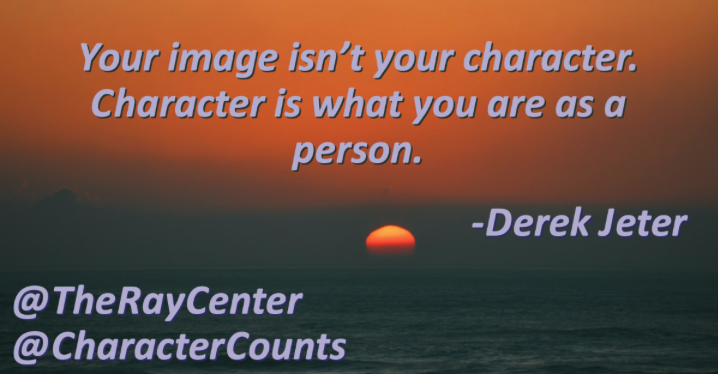Return to learn: Trustworthiness
This year, perhaps more than any other, parents, educators, and students are making incredibly challenging decisions. It’s important in these moments to assume best intentions, and trust that everyone is trying to do what they think is right and necessary to ensure a safe and impactful education experience.
In situations where there isn’t a clear and obvious answer, it’s useful to have a tool, like the Integrity-in Action Checklist, to help check our decision-making. Not every decision will pass each test below. Sometimes, the right decision isn’t fair to everyone, for example. However, checking your actions against the Integrity-in-Action Checklist can help ensure that you make good choices and maintain trust.
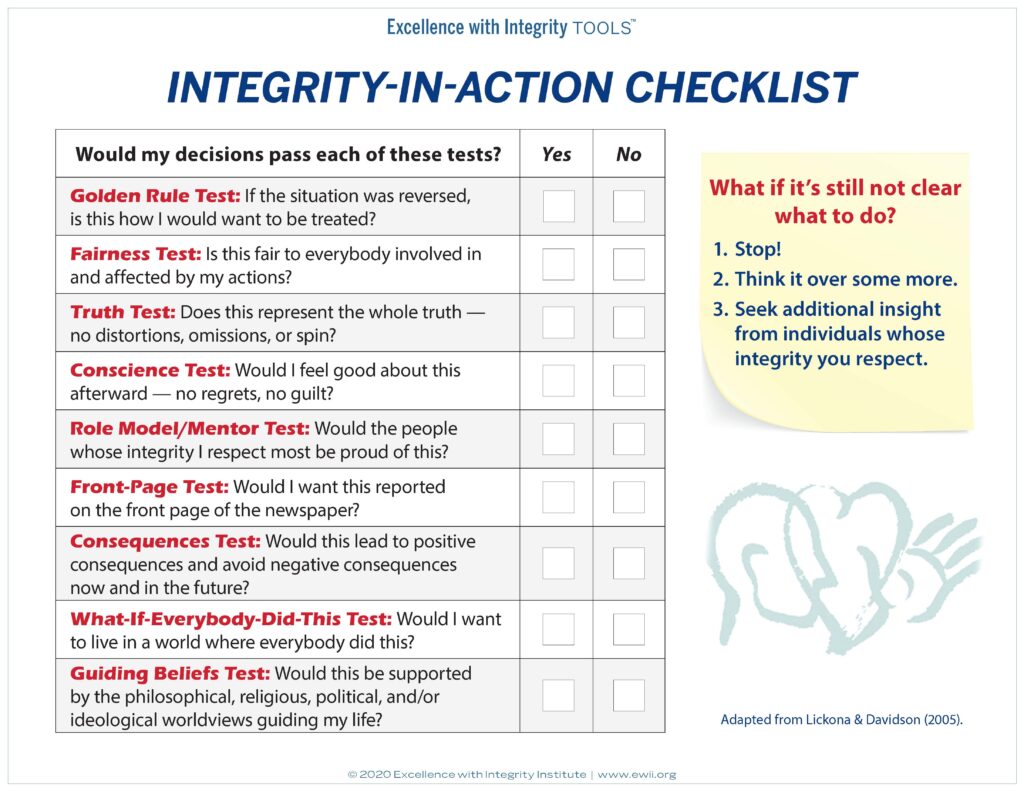
Trustworthiness for Educators: Even people with the best of intentions can sometimes make the wrong decision, especially when navigating the countless changes created by a global pandemic. As you work to bring students back to the classroom safely, or migrate your lessons to online delivery, use the Integrity-in-Action Checklist to make sure the choices you make are thoughtful and build trust with students, parents, and your colleagues.
Trustworthiness for Students: Students can use the Integrity-in-Action Checklist to help them make choices that could impact the health and safety of others. (“Is it fair to my classmates if I don’t follow guidelines to help stop the spread of COVID-19?”) Likewise, students working remotely can use the checklist to help make good decisions about how they engage with school. (“Do I want others to know that I was watching TV rather than paying attention to this online lesson?”)
Trustworthiness for Parents: The decisions parents make in the best interest of their child also impact the health, safety, and learning experiences of everyone else at school. Use the Integrity-in-Action Checklist to make sure the decisions you make are not only good for your children, but the teachers and other students with whom they interact. In addition, families can use the checklist to help guide the decisions their students make. “I know it’s uncomfortable to wear a mask, but let’s look at the truth test. While the mask is uncomfortable, the truth is I can wear it, get used to it, and keep myself and others safe.”
Making Good Decisions in Tough Times
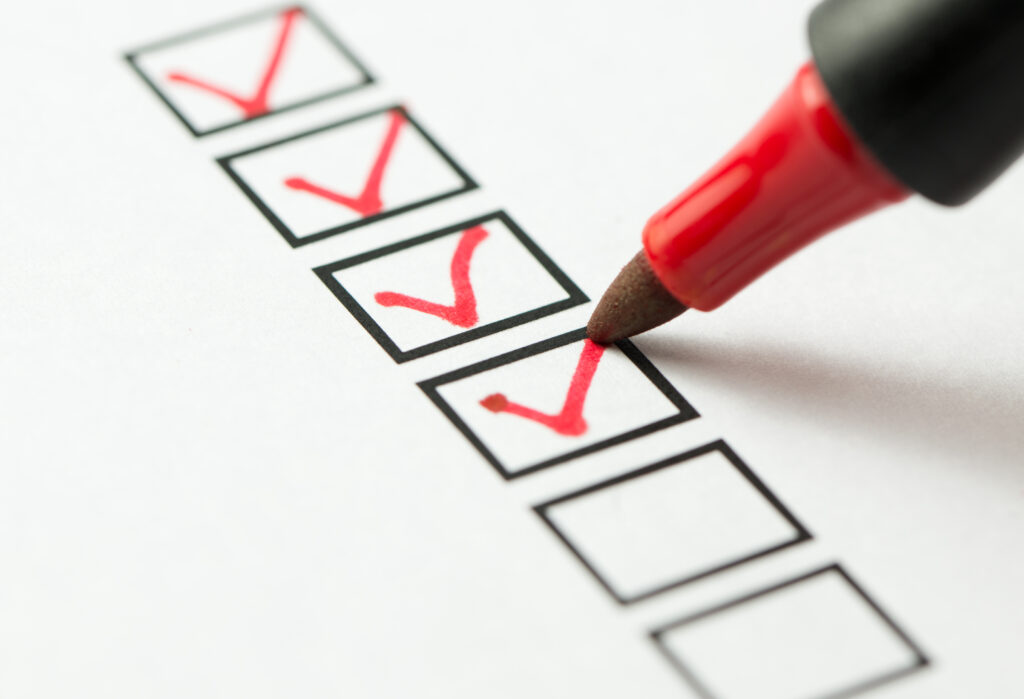
We all make countless decisions every day. Should you wear a face mask while out in public? Attend a social justice protest? Confront someone you disagree with?
Some of these decisions have relatively minor consequences (good or bad), while other decisions could have significant implications for us and others. A tool like the Character-in-Action Checklist (below) can help you navigate complicated choices and make the right decision.
When making a decision, ask yourself:
- Will my words and actions be honest, sincere, and reliable?
- If the situation was reversed, is this how I would hope to be treated?
- What are the consequences of my words and actions if I make this choice?
- Is my decision fair to everyone involved in and affected by my actions?
- Is my decision expressing compassion and kindness?
- Would I want to live in a world where everyone makes this choice?
Not every decision will align with each of the Six Pillars of Character. They can come into conflict with each other and even themselves. For example, sometimes the right decision isn’t fair to everyone involved. However, by identifying that a decision may not be fair, you can address the issue, explain why you made the decision, and provide support to those who perceive the decision as unfair. Or, sometimes the right choice may be contrary to a previous commitment, thus not in alignment with the trustworthiness test. Knowing this can help you determine how to honor your word when your decision doesn’t allow you to keep your word.
We’re facing troubling times and we can all contribute to the greater good by making sound decisions that reflect our best selves.
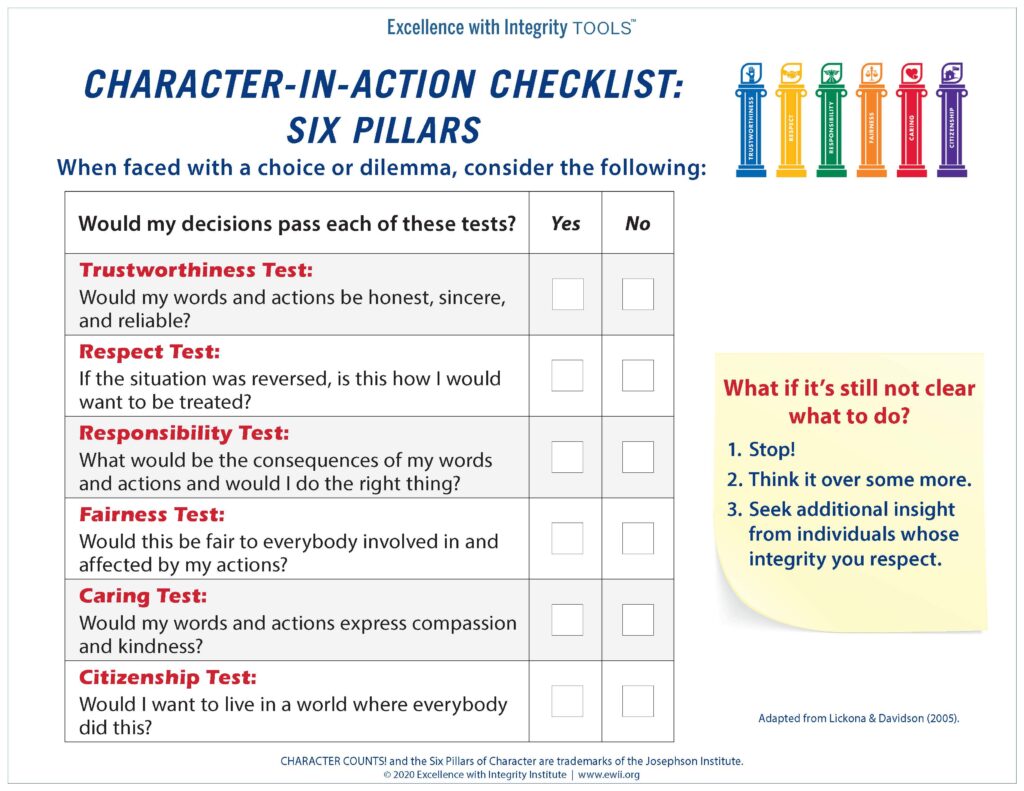
Character During Crisis

We are living through challenging and turbulent times. Americans are facing an international health pandemic, financial uncertainty, racial tensions, and civil unrest. It can be easy to feel helpless – wondering what possible impact someone like me can have on such great problems?
We can start with what is within our control: our character. Start by reflecting on the Six Pillars of Character (trustworthiness, respect, responsibility, fairness, caring and citizenship). Think of the Six Pillars of Character as ‘I’ and ‘action.’ We can ask ourselves: what am I doing to act in a capacity worthy of trust, how am I demonstrating respect, am I being responsible for my actions and consequences of my choices, are my decisions fair and equitable to those that are impacted, am I demonstrating a caring heart, am I being a good citizen fulling my duties and responsibilities?
Values like the Six Pillars guide us through difficult times and the actions we take. It is in these moments that we would do well to remember the words of Edward Everett Hale.
“I am only one, but I am one. I cannot do everything, but I can do something. And because I cannot do everything, I will not refuse to do the something that I can do.”
This is our challenge. What is the thing you can do? And not just today, but tomorrow, and next week, a year from now, and for the rest of your life because we know that there is always a way for us to get better, individually and collectively.
The issues that confront us are immense and it can be tempting to cave to feelings of inadequacy. But the fact remains, while you cannot do everything, you can do something. And remember, character counts in everything you do.
Building Trust (Grades K-5)

Students recognize the central role honesty plays in generating trust and they demonstrate their honesty in their communications in three ways:
- Truthfulness. Students are truthful; everything they say is true to the best of their knowledge (i.e., they do not lie);
- Sincerity. Students are sincere. This means they always convey the truth as best they can by avoiding all forms of accidental or intentional deception, distortion or trickery (e.g., it is dishonest to tell only part of the truth in an effort to create a false impression or deliberately omit important facts with the intent to create a false impression); and
- Candor. Students know that certain relationships (e.g., parent-child, teacher-student, best friends) create a very high expectation of trust. In these relationships, honesty requires them to be candid and forthright by volunteering information to assure that they are conveying the truth, the whole truth, and nothing but the truth. (e.g., a student who accidentally spills soda on a school computer must voluntarily tell the teacher without being asked; a student who breaks her mother’s favorite vase must tell her mother voluntarily).
Character Education Objectives:
- Students will reflect on how trust is built and broken in a friendship.
Content Goal
- Students will define trustworthy behaviors and demonstrate the impact of broken trust.
Language Goal:
- Students will write about things they can do to build their own trustworthy behaviors.
Purpose:
Trust in a relationship is not built overnight. It takes a series of trustworthy actions and behaviors to build it up. Unfortunately, one untrustworthy action can break trust instantly. This lesson is designed to demonstrate how our actions impact trust in a friendship and allow students to explore the concepts of truthfulness, sincerity and candor.
Lesson:
Discussion (5 min)
Have a large or small group discussion about what does being trustworthy mean? Talk about what it looks like and what is does not look like. Ask students to share examples of trustworthiness they have seen.
Activity (10 min)
Build a trust tower.
- Give each child a few blocks. You can use Jenga blocks, building blocks or anything you have in the classroom. You want the students to be able to successfully build the tower, so be sure to plan with the right number of blocks. The best plan is to build the tower with layers of three blocks each, alternating direction on each layer. See the game Jenga for an example.
- Ask the students one by one to come up and build a tower of trust. Each block represents something they can do to build trust. Ask students to say out loud what they can do to build trust as they place the block. Give all students an opportunity to add one or multiple blocks until you have your tower.
- Explain to students that you have built this wonderful tower of trust. It’s much like a friendship and it takes work to build by consistently being trustworthy. Sometimes we choose actions that are not trustworthy and that will start to break down that tower.
- Have prepared statements of untrustworthy actions from your discussion ready. Read a statement and ask one student pull one block for each statement. The student can choose any block. Continue until the tower falls.
Discussion (10 min)
Talk with students about how trust in friendships is built just like they built the tower. One by one your actions show the other person you are trustworthy. When you choose a behavior or action that is untrustworthy it starts to break down that tower. The first untrustworthy action may not knock the tower down, but it may. Could it be the second time? The third? You never know when that tower will fall and that trust will break.
Ask the students to discuss the following questions:
- Is it easier to build trust or to break it down?
- How do you rebuild trust with a friend once it has been broken?
- Are there any times it is ok to be dishonest?
Journal (5 min)
What can I do to be more trustworthy?
Family Connection:
Ask families to replicate the activity you did in class, but think about how they build trust in their family.
- Draw a line down a piece of paper. On one side write/draw examples of how they show trustworthiness in the family. On the other side write/draw examples of what untrustworthy behaviors could be in the family.
- You are going to build a trust tower. You will need blocks. Fifteen blocks are great, as you can lay them in 5 layers with 3 blocks in each layer while alternating directions. The game Jenga is a great reference point for this.
- Ask each family member to place one block at a time. As they place the block, ask them to share something they can do personally to help build trust in the family. Repeating answers is ok because it is all about what that individual can do. Continue until you have a tower of trustworthy behavior.
- Now, look at your list you made. Read your untrustworthy behaviors one at a time. As you read them, have someone pull any block from the tower. As you start to pull blocks, talk about how sometimes you choose behaviors that are untrustworthy. One time probably will not knock down the tower, but it might. Could it be two behaviors? Three? You never know when that tower of trust that you worked so hard to build in your family may fall.
- Have a discussion with your family around the following questions:
- How do we rebuild trust in our family once it has been broken?
- Is it easier to build trust or destroy trust? Why?
Traits of Trustworthy People (Grades 6-12)

Character Education Objective:
- Students will discuss traits of trustworthy people.
Content Goal
- Students will list opportunities to improve their #TrustTraits.
Language Goal:
- Students will list the traits of trustworthy people in their lives and highlight them in a reading about being trustworthy.
Purpose:
We have many examples of trustworthy individuals in our lives, but we do not always stop to reflect what character traits are present in someone we trust. This lesson will examine nine traits of trustworthy people. Participants will determine if they have trustworthy characteristics, and which ones they could improve upon in their own lives.
Lesson
Independent (3 min)
Journal:
- Would you trust you?
- Why or Why Not?
Productive Group Work (12 min)
Read this article, highlight traits of trustworthy people, and answer the questions in a group
- Who is a person in your life that you trust?
- What about their character makes you trust them?
- What did you learn are traits of trustworthy people?
What is a trait mentioned in the article you are strong in, and one where you are weak?
Group discussion (5 min)
- What did you learn?
- How can we be more trustworthy?
- What is a weakness you
ant to improve upon to be more trustworthy?
Family Connection
- Tech Support
- Send a snapchat to your child about being trustworthy
- The next time your child does something trustworthy, post it on social media or text them kudos and a heartfelt message
- Pillar Time
- Volunteer as a family at the Animal Rescue League or another local area to show trustworthy character
- Play Blind retriever- blindfold one person and guide them with words to pick up an object across the yard or room.
- Dinner Discussion
- Who is a person in your life that you trust?
- What about their character makes you trust them?
- What is challenging about being trustworthy?
- How can you work as a family to become more trustworthy?
Way To Go Lesson Plans
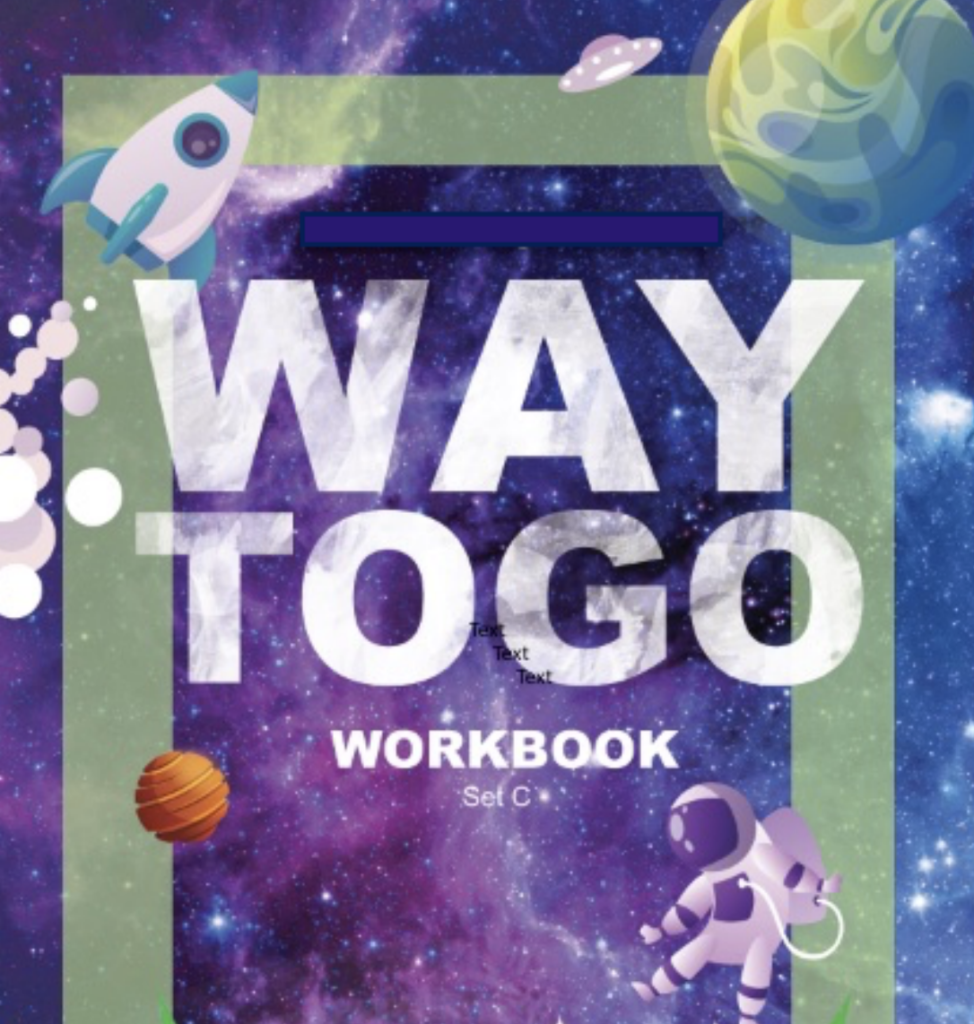
CC! can help schools with a resource to provide online lessons for use during this time that schools are closed.
Teachers can share with students a 10-12 minute lesson incorporating compelling images, quotations and thought-provoking short writing and discussion activities that focus on each of the three core domains of student development: academic, social/emotional and character.
We are providing a number of these lessons free to any teacher that would like to incorporate character into their online learning experiences.
Elementary School Way To Go Lessons
The Six Pillars of Character and the Holidays

As we gather around those who are most important to us this holiday season, we should keep in mind the Six Pillars of Character. Each Pillar can offer a new way to spread holiday cheer and joy to friends, family, coworkers, neighbors and even strangers.
Trustworthiness It can take a lot for us to put our trust in someone and for someone to trust us, and the holiday season is a great time to work on building trust. The most simple and straightforward way to build trust is to keep your word. If you say you’ll do something, do it. If you make a promise, keep it. During the holidays, we often count on one another to get the gifts, make the food, send the cards out or put up the decorations. By keeping track of and completing your holiday responsibilities you become dependable and build trust. Trust can even be built by inviting new people to your holiday gatherings, cooking a dish for a family in need or shoveling snow for a neighbor.
Respect Sometimes respect can get lost in the shuffle of the hectic holidays. When we are in crowded stores it can be easy to get frustrated with store employees or other shoppers. We need to remember that we are all doing our best, but sometimes stress can get the best of us. In these times, we should remember to always treat others how we would want to be treated. Being kind and forgiving to overworked retail employees, letting a busy family go ahead of us in line or using reusable shopping bags shows that we have respect for those around us and the environment. The holidays are all about being grateful, so show those around you that you respect them by following the golden rule.
Responsibility If you’re the one hosting a holiday gathering, you have a lot of responsibility on your shoulders. Always keep your word and do what you said you were going to do, but don’t be afraid to ask for help. If you need friends or family to bring a dish, help you clean up or watch your kids or pets, reach out to them. This can help you meet your responsibilities, but also help show you how responsible others in your life are.
Fairness It’s always the thought that counts. The holidays are not about comparing gifts that you have given or received. The holidays should be focused on celebrating the relationships of those closest to us. It can be easy to get caught up in the material things and the gift-giving, but making sure that we treat those around us with fairness should be at the forefront of our minds.
Caring There are countless ways that we can show that we care this holiday season. We usually show that we care by giving gifts to our loved ones, but we can show that we care in other ways as well. By donating our unused clothing, donating blood, cooking for a family in need or simply sending holiday cards we can show that we are thinking about all members of our community. For those that don’t have close families or don’t have the means to buy gifts, the holidays can be a difficult time. So, let’s show them that we care and want them to have a merry holiday season.
Citizenship The holidays are a great time to show that we are dedicated citizens. One of the best and easiest ways we can do this is by supporting local businesses and local restaurants. We can show our support of our communities if we do our holiday shopping at local stores that are run by our neighbors. Going to events put on around the neighborhood is also important. Whether it’s a craft fair, a holiday light show or an ice skating event, we can connect with members of our community while supporting those who make our communities so special.
Interpersonal Skills (Grades 6-12)

Character Education Objective:
- Students will discuss how to develop and maintain positive relationships in their lives.
Content Objective:
- Students will define, establish, and maintain healthy relationships.
Language Objective:
- Students will employ strategies to promote positive relationship building and connections.
Purpose:
Human beings need opportunities to build and maintain positive relationships in all stages of life. Providing teens with opportunities to develop a clear definition of what healthy relationships look and sound like is important to help ensure health development, physically, socially, and emotionally. Creating positive models and situations to practice healthy boundaries and communication is important to grow relationships and social connections.
Lesson
Independent
- Who do you have a healthy, positive relationship within your life?
- How does this connection with this individual make you feel?
Productive Group Work:
- Read this article and/or infographic about connection and the impact on health.
- List the impact of human connections on health
Whole Group Discussion:
- What did you learn?
- What are some ways to spend more time with friends?
Reflection Journal (Independent task)
- Compare and Contrast the feelings/benefits of social media time with friends and in-person time with friends
- How will you get out from behind the screen and be seen this week?
#BeSeen
#CharacterCounts
Interpersonal Skills (Grades K-5)

Character Education Objective:
- Students will discuss how connection increases communication and collaboration.
Content Objective:
- Students will discuss what the Six Pillars look like in them, their friends and the people they admire.
Language Objective:
- Students will journal about how they can actively work to connect with one another.
Purpose:
Including intentional connection time with your students is a great way to show the importance of connecting with one another. When we are connected we communicate better, collaborate more successfully and assume better intentions in one another. We often think of connection as something to check off the list at the beginning of the year a getting to know you activity, but in reality it is something that needs to happen regularly. The following activity will allow students to connect over character traits they see in themselves and those that are important to them.
Lesson
- Watch “Six Pillar Shuffle” and encourage the students to dance along.
- Electricity Split the students in two equal groups. Each group will be a team. Encourage them to get together and create team names. One team will get in a line standing shoulder to shoulder and all facing one way. The other team will get in another line shoulder to shoulder and facing the other team. The lines should be a few feet apart. There should be an aisle between the lines.
- If students point directly in front them, they should be pointing at only one student and one student should be pointing at them. This is their partner for the first round. Have students discuss the following question with their partner: What’s your favorite cartoon character?Now, students will play a game to get their next partner. To set up, you keep the teams in their lines and determine which side will be the start and which side will be the end of the line. At the end of the line, place an item on the ground evenly between the last two players of each team. The game is passing a high five down their team’s line from the starting side until it gets to the last person. The only rule is that you may not pass the high five until the high five is given to you.
- Once the high five hits the last person then the last person will grab the item from the ground. The first team to grab the item is the winner. The team that lost will move one person to the left. The person on the furthest left spot will walk down the aisle to the other end of the line. If you want, encourage the students to do a little Six Pillar Shuffle down the aisle! This should give students a new partner. With their new partner, have students discuss: What makes a person trustworthy? Have the students get ready to pass along the high five again.
- Once the winning team is determined, have the team that lost move one to the left again. This will give the students a new partner. Have the new partners discuss a question and then repeat the game and questions until you have answered all of them: How do you respect your friends? Who is someone in your life you think is responsible? Why? Was there a time in your life when something was unfair? How did you handle that?How has someone show you they cared for you? Who is someone you admire that shows good citizenship?
- When the game is done, talk about the power of connection. When we do these games, we are connecting with one another and finding things we have in common or how we think similarly. When we find that connection with someone we are kinder, more respectful and work better together. It’s important to take the time to connect with each other and it doesn’t always take a game. Encourage students to take the time to connect to someone they don’t know well during lunch, recess, group projects or collaboration times in the classroom.
- Have the students journal about ways they can make connections throughout the day. Connection is not something you can do just once and check it off the list. It must be done continually. Connection is also something that doesn’t always come naturally and sometimes needs to be intentionally planned. During this journaling time, you should encourage students to think about those two things and how they will work in connection into their day more frequently.
Family Connection
Give a brief overview of the importance of connection. Encourage families to watch a video about the power of connecting with those who may look and think differently than you: https://www.youtube.com/watch?v=sQuM5e0QGLg
Give the families the following prompts to connect around character development:
- What makes a person trustworthy?
- How do you respect your friends?
- Who is someone in your life you think is responsible? Why?
- Was there a time in your life when something was unfair? How did you handle that?
- How has someone show you they cared for you?
- Who is someone you admire that shows good citizenship?
